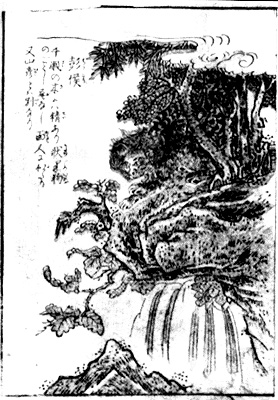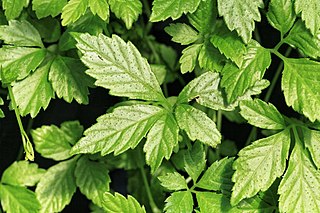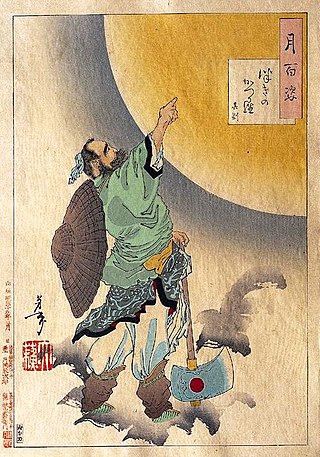Chinese food therapy is a mode of dieting rooted in Chinese beliefs concerning the effects of food on the human organism,and centered on concepts such as eating in moderation. Its basic precepts are a mix of Taoist Wuxing theory and concepts drawn from the modern representation of traditional Chinese medicine.

Chinese herbology is the theory of traditional Chinese herbal therapy,which accounts for the majority of treatments in traditional Chinese medicine (TCM). A Nature editorial described TCM as "fraught with pseudoscience",and said that the most obvious reason why it has not delivered many cures is that the majority of its treatments have no logical mechanism of action.

Laurus nobilis is an aromatic evergreen tree or large shrub with green,glabrous (smooth) leaves. It is in the flowering plant family Lauraceae. It is native to the Mediterranean region and is used as bay leaf for seasoning in cooking. Its common names include bay tree,bay laurel,sweet bay,true laurel,Grecian laurel,or simply laurel. Laurus nobilis figures prominently in classical Greco-Roman culture.

Cinnamomum cassia,called Chinese cassia or Chinese cinnamon,is an evergreen tree originating in southern China and widely cultivated there and elsewhere in South and Southeast Asia. It is one of several species of Cinnamomum used primarily for its aromatic bark,which is used as a spice. The buds are also used as a spice,especially in India,and were used by the ancient Romans.

The Bencao gangmu,known in English as the Compendium of Materia Medica or Great Pharmacopoeia,is an encyclopedic gathering of medicine,natural history,and Chinese herbology compiled and edited by Li Shizhen and published in the late 16th century,during the Ming dynasty. Its first draft was completed in 1578 and printed in Nanjing in 1596. The Compendium lists the materia medica of traditional Chinese medicine known at the time,including plants,animals,and minerals that were believed to have medicinal properties.

Baijiu,also known as shaojiu (烧酒/燒酒),is a colorless Chinese liquor typically coming in between 35% and 60% alcohol by volume (ABV). Each type of baijiu uses its own type of qū for fermentation to create a distinct and characteristic flavor profile.

Osmanthus fragrans,variously known as sweet osmanthus,sweet olive,tea olive,and fragrant olive,is a species native to Asia from the Himalayas through the provinces of Guizhou,Sichuan and Yunnan in Mainland China,Taiwan,southern Japan and Southeast Asia as far south as Cambodia and Thailand.

Cinnamomum tamala,Indian bay leaf, also known as tejpat,tejapatta,Malabar leaf,Indian bark,Indian cassia,or malabathrum,is a tree in the family Lauraceae that is native to India,Bangladesh,Nepal,Bhutan,and China. It can grow up to 20 m (66 ft) tall. Its leaves have a clove-like aroma with a hint of peppery taste;they are used for culinary and medicinal purposes. It is thought to have been one of the major sources of the medicinal plant leaves known in classic and medieval times as malabathrum.

Fermented tofu is a Chinese condiment consisting of a form of processed,preserved tofu used in East Asian cuisine. The ingredients typically are soybeans,salt,rice wine and sesame oil or vinegar. In mainland China the product is often freshly distributed. In overseas Chinese communities living in Southeast Asia,commercially packaged versions are often sold in jars containing blocks 2- to 4-cm square by 1 to 2 cm thick soaked in brine with select flavorings.

Snake wine is an alcoholic beverage produced by infusing whole snakes in rice wine or grain alcohol. The drink was first recorded to have been consumed in China during the Western Zhou dynasty and believed in folklore to reinvigorate a person according to Traditional Chinese medicine. It can be found in China,Hong Kong,Taiwan,North Korea,Goa (India),Vietnam,Okinawa (Japan),Laos,Thailand,Cambodia and throughout Southeast Asia.

The Penghou is a tree spirit from Chinese mythology and folklore. Two Chinese classics record similar versions of the Penghou myth.

Senna obtusifolia,known by the common names Chinese senna,American sicklepod,sicklepod,etc.,is a plant in the genus Senna,sometimes separated in the monotypic genus Diallobus. It grows wild in North,Central,and South America,Asia,Africa,and Oceania,and is considered a particularly serious weed in many places. It has a long-standing history of confusion with Senna tora and that taxon in many sources actually refers to the present species.

Gynostemma pentaphyllum,also called jiaogulan,is a dioecious,herbaceous climbing vine of the family Cucurbitaceae widely distributed in South and East Asia as well as New Guinea. Jiaogulan has recently been incorporated into traditional medicine.

Li Shizhen,courtesy name Dongbi,was a Chinese acupuncturist,herbalist,naturalist,pharmacologist,physician,and writer of the Ming dynasty. He is the author of a 27-year work,the Compendium of Materia Medica. He developed several methods for classifying herb components and medications for treating diseases.

Wu Gang,formerly romanized as Wu Kang and also known as Wu Zhi in some sources,is a figure in traditional Chinese folklore and religion. He is known for endlessly cutting down a self-healing osmanthus tree on the Moon,a divine punishment which has led to his description as the Chinese Sisyphus. In modern Chinese,the chengyu "Wu Gang chopping the tree" is used to describe any endless toil. The specific reason for his situation has varied in the sources,but Wu Gang's story dates back to at least the Tang dynasty.

Huáng bǎi,huáng bó or huáng bò is one of the fifty fundamental herbs of traditional Chinese medicine. Known also as Cortex Phellodendri,it is the bark of one of two species of Phellodendron tree:Phellodendron amurense or Phellodendron chinense.
In Chinese mythology and folklore,Fēng was an edible monster that resembles a two-eyed lump of meat and magically grows back as fast as it is eaten. Early Chinese texts also referred to this legendary food with the names Shìròu,Ròuzhī,and Tàisuì. Ròulíngzhī is a modern name popularized by Chinese news media reporting on purported discoveries of Feng throughout China.

Li Shizhen's (1597) Bencao gangmu,the classic materia medica of traditional Chinese medicine (TCM),included 35 human drugs,including organs,bodily fluids,and excreta. Crude drugs derived from the human body were commonplace in the early history of medicine. Some of these TCM human drug usages are familiar from alternative medicine,such as medicinal breast milk and urine therapy. Others are uncommon,such as the "mellified man",which was a foreign nostrum allegedly prepared from the mummy of a holy man who only ate honey during his last days and whose corpse had been immersed in honey for 100 years.

Kung Pao chicken,also transcribed Gong Bao or Kung Po,is a spicy,stir-fried Chinese dish made with cubes of chicken,peanuts,vegetables,and chili peppers. The classic dish in Sichuan cuisine originated in the Sichuan province of south-western China and includes Sichuan peppercorns. Although the dish is found throughout China,there are regional variations that are typically less spicy than the Sichuan serving. Western Kung Pao chicken is also a staple of Westernized Chinese cuisine.

Huangjiu is a type of Chinese alcoholic beverage most popular in the Jiangnan area. Huangjiu is brewed by mixing boiled grains including rice,glutinous rice or millet with qū as starter culture,followed by saccharification and fermentation at around 13–18 °C (55–64 °F) for fortnights. Its alcohol content is typically 8% to 20%.



















